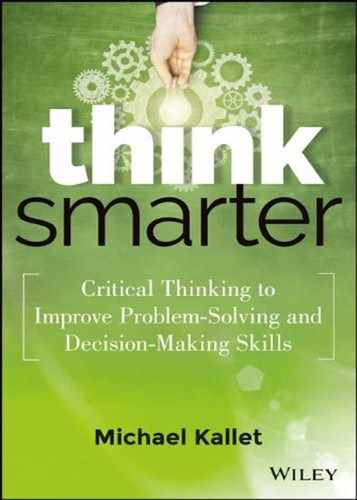10 What Else?
What Else Could This Be?
We've already determined that one reason to ask why is to get to a root cause. Why did something happen—or what could explain why something happened? What else is another tool used in this discovery. When ideas start to subside, asking what else stimulates lateral thinking with respect to new possible explanations. What else is a tool to prevent coming to a premature conclusion about what happened—or what to do next.
Physicians use what else often when diagnosing a medical issue. When you visit a doctor and are displaying obvious symptoms, it would be easy for him or her just to say, “Oh, you have a cold.” Asking “What else can cause these symptoms?” could lead to a blood test, strep test, or other questions, such as “Do you have any pain here?” What else continues the investigation—and allows you to discover other potential causes.
A very effective way to ask the what else question is to say “What else could possibly cause this?” The word possibly opens the door to ideas, no matter how remote, that could be a cause. In your automatic mode you might typically discard such unlikely causes, but in critical thinking you consciously evaluate them.
What else can also acknowledge a good idea while keeping the conversation going. For example, why was your product launch so successful? One response might be: “Because we had it so well organized and orchestrated.” Your response might be: “Okay, is there anything else that may have contributed to success?” Someone might add: “Because we applied the lessons from the last launch and this time staffed the phones at a level no one thought we would need, but ended up using.” Keep probing: “Okay, anything else?”
When people communicate, they often surprise one another with their reactions. It's called a miss on anticipatory thinking: “Gee, I thought they would be happy to hear this.” You might ask yourself, “What other (what else) interpretation might be going on here? What else are they involved in that could have changed how they viewed this?”
Getting Started with What Else
Here are a few places you can use what else:
- When you want to augment inspection with what else: When defining words, ask what else they could mean. How else could this be interpreted? What other meanings could be attached to these words? For example, someone might define quality as a measure of defects. Asking what else quality means might result in conversations about ease of use or availability of customer support, or how to buy or maintain a product.
- When you think you know the reason for something: Keep thinking about what else could have caused this thing, or is causing it, until you've exhausted possibilities.
- When you thought you knew the reason for something: When you investigate the cause that you think is responsible for something and discover that it isn't the cause, it's time to ask, “What else could possibly cause this?” There is always a cause for things that happen, so if your initial evaluation fails to result in identifying the cause, keep asking what else.
- During brainstorming: Use what else to encourage new ideas, new concepts, and new explanations. Ask questions such as “What else do our customers ask for?” or “What else can we do on our vacation?”
- When building or designing something: Ask, “What other (else) ways can we accomplish this?”
- Augment what's next with what else: When asking what's next or what the consequences for a given action might be, ask what else to stimulate thinking about additional what's next items or consequences.
The Takeaway
Ask what else to keep the thinking going, to stimulate new ideas and new possibilities, and to prevent premature closure of an issue, idea, or solution.
Exercises for What Else
- Think about a goal you have and the things to do related to that goal. Ask what else you should be doing.
- The next time someone says, “I think I know what's going on,” listen to his or her explanation and ask, “Could there be anything else that caused this?”
- Look at the last five e-mails you wrote. Other than what you intended, what else could they be interpreted to mean?
- Pick up any item your desk. What is it used for? Write down 25 other possible uses for that item. Keep asking yourself, “What else?”
